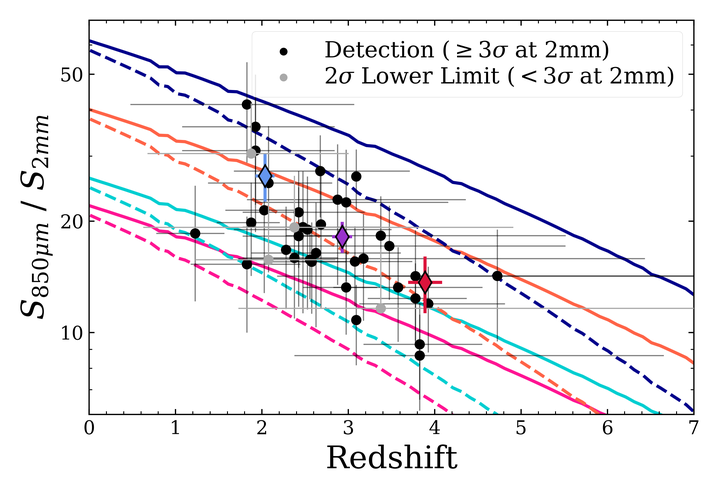Searching Far and Long. I. Pilot ALMA 2 mm Follow-up of Bright Dusty Galaxies as a Redshift Filter
 Figure 6 in Cooper et al. 2022
Figure 6 in Cooper et al. 2022
A complete census of dusty star-forming galaxies (DSFGs) at early epochs is necessary to constrain the obscured contribution to the cosmic star formation rate density (CSFRD); however, DSFGs beyond z ~ 4 are both rare and hard to identify from photometric data alone due to degeneracies in submillimeter photometry with redshift. Here, we present a pilot study obtaining follow-up Atacama Large Millimeter Array (ALMA) 2 mm observations of a complete sample of 39 850 μm-bright dusty galaxies in the SSA22 field. Empirical modeling suggests 2 mm imaging of existing samples of DSFGs selected at 850 μm-1 mm can quickly and easily isolate the ‘‘needle in a haystack’’ DSFGs that sit at z > 4 or beyond. Combining archival submillimeter imaging with our measured ALMA 2 mm photometry (1σ ~ 0.08 mJy beam-1 rms), we characterize the galaxies’ IR spectral energy distributions (SEDs) and use them to constrain redshifts. With available redshift constraints fit via the combination of six submillimeter bands, we identify 6/39 high-z candidates each with >50% likelihood to sit at z > 4, and find a positive correlation between redshift and 2 mm flux density. Specifically, our models suggest the addition of 2 mm to a moderately constrained IR SED will improve the accuracy of a millimeter-derived redshift from Δz/(1 + z) = 0.3 to Δz/(1 + z) = 0.2. Our IR SED characterizations provide evidence for relatively high-emissivity spectral indices (<β> = 2.4 ± 0.3) in the sample. We measure that especially bright (S 850μ m > 5.55 mJy) DSFGs contribute ~10% to the cosmic-averaged CSFRD from 2 < z < 5, confirming findings from previous work with similar samples.